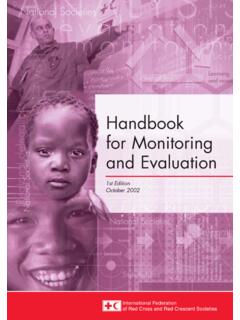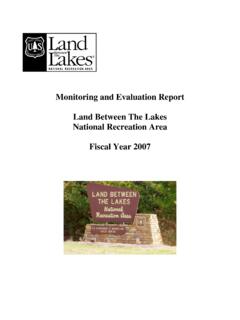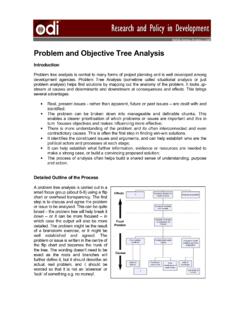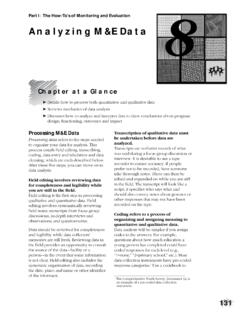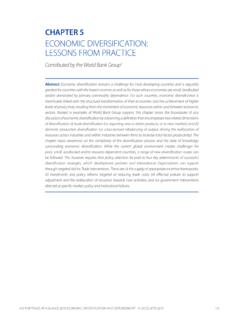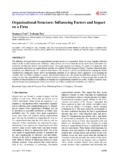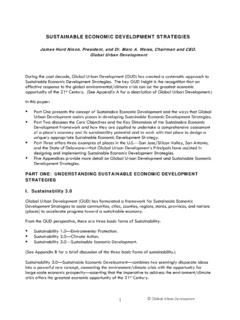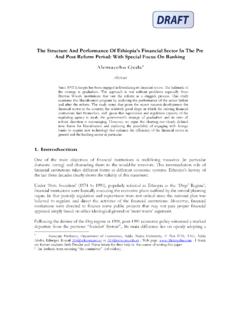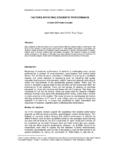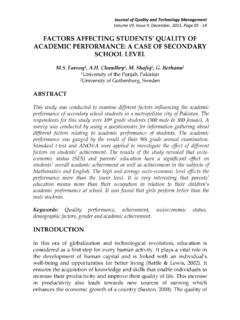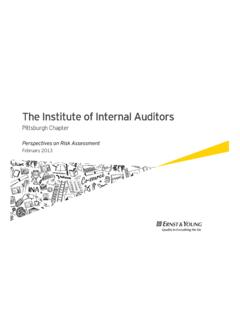Transcription of Performance Monitoring Indicators - MEASURE Evaluation
1 Performance Monitoring Indicators A handbook for task managers O P E R AT I O N S P O L I C Y D E PA R T M E N T. WORLD BANK. WA S H I N G T O N , D . C . 1996. Contents Foreword v Acknowledgments vi Performance Monitoring Indicators 1. What are Performance Monitoring Indicators ? 1. Why are Performance Monitoring Indicators important? 1. Portfolio Management Task Force findings 1. OED studies 2. Next Steps Action Plan 2. What are the advantages of Performance Monitoring Indicators ? 3. How are Performance Monitoring Indicators developed? 4. The logical framework 4. Antecedents to the logical framework 5. Importance of clarifying assumptions 7. Hierarchy of objectives and the link to Performance Indicators 8. Organizing the hierarchy of objectives 8.
2 Types of Performance Indicators 11. Results Indicators 11. Risk Indicators 14. Efficacy Indicators 14. Ways of measuring Performance 15. Direct measures 15. Indirect measures 15. Early pointers: intermediate and leading Indicators 15. Quantitative and qualitative measures 16. Measurement scope 17. Special studies 17. General principles for selecting Indicators 18. Problems with defining Indicators 18. Problems with measuring impact 18. Indicator benchmarks and international comparators 19. How do Performance Monitoring Indicators affect the Bank's work? 19. economic and sector work 19. Project cycle 20. Project identification, preparation, and preappraisal 20. iii Appraisal and negotiations 21. Implementation and supervision 21.
3 Evaluation 21. Performance Indicators and project management 21. Field-level implementers 22. Implementation unit managers 22. Borrower officials and Bank staff 23. Some related issues 23. Good practice in Monitoring and Evaluation 23. Data collection and management 24. Institutional arrangements and capacity building 25. Feedback from Monitoring and Evaluation efforts and interpreting Indicators 25. Relation to loan covenants 26. Working at cross purposes 26. Last word 27. Notes 27. Sectoral notes on Indicators 28. What topics do the notes cover? 28. How were the notes developed? 29. How are Indicators selected from the notes? 29. Where are the notes available? 29. How to learn more 29. Examples of Indicators 31. Table 1 Honduras Basic Education Project (SAR 13791-HO, March 8, 1995) 32.
4 Table 2 Indonesia Rural Electrification Project (SAR 12920-IND, February 3, 1995) 33. Table 3 Indonesia: Second Agricultural Research Management Project (SAR 13933-IND, April 21, 1995) 35. Table 4 Lithuania Siauliai Environment Project (SAR 14981-LT, November 9, 1995) 37. Table 5 Peru Rural Roads Rehabilitation and Maintenance Project (SAR 14939-PE, November 6, 1995) 38. Table 6 The Philippines Women's Health and Safe Motherhood Project (SAR 13566-PH, January 27, 1995) 40. Table 7 Venezuela Agricultural Extension Project (SAR 13591-VE, March 7, 1995) 42. Table 8 Chad: Structural Adjustment Credit (President's Report P-6785-CD) 43. Table 9 Morocco: Financial Markets Development Loan (President's Report P-6633-MOR) 45. iv Foreword As part of ongoing efforts to improve the quality and impact of its work, the World Bank is placing new emphasis on the use of Performance Monitoring Indicators .
5 These Indicators , which are based on a logical framework of project objectives and end- means relationships, help generate more thoughtful, logically constructed project designs. And because they serve as benchmarks against which to MEASURE project progress toward development objectives, they result in more meaningful project moni- toring and Evaluation . Over the past two years Bank staff have developed notes on suggested Performance Monitoring Indicators for each of the main sectors in which the Bank is active. These notes offer a framework for use by task managers, borrowers, and pro- ject implementation units in analyzing the relationship between objectives and moni- torable outcomes and impacts. They also offer a menu of possible Indicators .
6 This handbook, which introduces and supplements the sector notes, is divided into three sections. The first section explains why menus of Indicators were developed;. provides the background on the logical framework and typology of Indicators ;. describes how Indicators are developed and applied in project design, supervision, and Evaluation ; and discusses important issues related to the meaningful use of indi- cators. The second section describes the sector notes on Indicators and their use and explains how to get copies. The third section provides examples of Performance indi- cators developed for Bank-financed projects and shows how the Indicators were developed on the basis of each project's development objectives. Myrna Alexander Director, Operations Policy May 1996.
7 V Acknowledgments This handbook was prepared by Roberto Mosse, Leigh Ellen Sontheimer, and Patricia Rogers of the Operations Policy Department at the World Bank. It was edited by Meta de Coquereaumont and Paul Holtz (American Writing Corporation). Laurel Morais and Christian Perez (American Writing Corporation) designed and laid out the text. The authors are grateful to Gerald Britan ( Agency for International Development), Moses Thompson (Teams Technologies, Inc.), Ulrich Thumm (Operations Evaluation Department, World Bank), and Deborah Wetzel (Development Economics, World Bank) for their valuable contributions and comments. The authors also thank the following Bank task managers for preparing objectives and Indicators matrixes: Maria Dalupan, Hennie Deboeck, Dely Gapasin, Jos Luis Irigoyen, Rama Lakshminarayanan, David Nielson, Arun Sanghvi, Anna Sant'Anna, Stanley Scheyer, Sari Soderstrom, and Christopher Walker.
8 Vi Performance Monitoring . Indicators . What are Performance Monitoring Indicators ? Performance Indicators are measures of project impacts, outcomes, outputs, and inputs that are monitored during project implementation to assess progress toward project objectives. They are also used later to evaluate a project's success. Indicators organize information in a way that clarifies the relationships between a project's impacts, outcomes, outputs, and inputs and help to identify problems along the way that can impede the achievement of project objectives. Why are Performance Monitoring Indicators important? In recent years several important studies most notably the Portfolio Management Task Force Report and reviews by the Operations Evaluation Department (OED).
9 Have found that the Monitoring and Evaluation of Bank-financed projects did not focus adequately on the factors that are critical for positive development impact. Both the task force and OED concluded that Performance Indicators should be integrated with the Monitoring and Evaluation procedures used by the Bank and its borrowers. The Portfolio Management Task Force Report (also known as the Wapenhans Report) Portfolio analyzed the factors that affect the development impact of Bank As part Management Task of this analysis the task force focused on how Evaluation methodologies, including the Force findings calculation of economic rate of return and the project rating methodology, were used during project appraisal and supervision to enhance the quality of Bank-supported projects.
10 The task force found that project ratings were not providing implementation units, borrowers, and Bank task managers with adequate feedback about progress toward development impact for several reasons: Too much emphasis was placed on the mechanics (physical and financial) of pro- ject implementation. The risks and factors that most influence project outcomes were poorly identified. Objective criteria, transparency, and since the methodology depended on the judgment of individuals consistency across units were lacking. Ratings tended to be overly optimistic. 1. Without appropriate feedback, none of the parties concerned with project outcomes could make appropriate, informed decisions about whether and how to adjust project design or implementation arrangements to better achieve a project's intended objectives.
